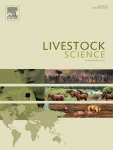Ver ítem
- xmlui.general.dspace_homeCentros Regionales y EEAsCentro Regional Buenos Aires SurEEA BalcarceArtículos científicosxmlui.ArtifactBrowser.ItemViewer.trail
- Inicio
- Centros Regionales y EEAs
- Centro Regional Buenos Aires Sur
- EEA Balcarce
- Artículos científicos
- Ver ítem
Ingestive behaviour, performance, and methane emissions of pregnant alpacas grazing cultivated pastures in the high Peruvian Andes
Resumen
This study compares grazing patterns, animal performance, and enteric methane emissions (CH4) of female alpacas (Huacaya and Suri) at two periods of their late pregnancy. Animals were rotationally grazed on a mixed sward at high Peruvian Andes conditions. This study involved two experimental periods (P1 and P2), each lasting 26 days. P1 took place in November 2021, corresponding to the end of dry season (‘Transition period’), whereas P2 was conducted in
[ver mas...]
This study compares grazing patterns, animal performance, and enteric methane emissions (CH4) of female alpacas (Huacaya and Suri) at two periods of their late pregnancy. Animals were rotationally grazed on a mixed sward at high Peruvian Andes conditions. This study involved two experimental periods (P1 and P2), each lasting 26 days. P1 took place in November 2021, corresponding to the end of dry season (‘Transition period’), whereas P2 was conducted in January 2022, with this coinciding with the beginning of rainy season (‘Wet period’). Forage selectivity was measured using hand plucking of forage harvested, whereas grazing behaviour was recorded by visual observation. Dry matter intake (DMI) was estimated from total faecal collection and in vitro forage digestibility. Fleece characteristics were measured following standard procedures adopted by the local industry. The sulphur hexafluoride (SF6) gas-tracer technique was used to estimate CH4 emissions. Data were analysed by a repeated measures model including both alpaca variety and period as fixed effects, whereas alpaca within variety was considered as random. No differences were detected among alpaca varieties either in terms of forage selectivity, grazing behaviour (except for biting rate) or feed intake. Regardless of period, grasses were the main dietary components (≥ 78 %). The proportion of leaves consumed lowered from 84 to 70% and presence of both legumes and herbs increased during P2. Increased nutritional requirements prior to parturition in conjunction with reduced forage quality and DMI (P = 0.004) during P2 led to negative energy and protein balances. This was aligned with increases in fibre growth and diameter, prior to parturition (P ≤ 0.035). Suri displayed faster fibre growth than Huacaya (P = 0.005). Although Huacaya females tended to emit more enteric CH4 per unit of metabolic live weight than Suri (P = 0.056), this was not reflected either on variety differences in emissions per unit of intake or fleece produced. On average, CH4 intensity decreased from 0.805 (P1) to 0.530 g/kg clean fleece at P2 (P = 0.032). Results are valuable towards fine-tuning the effect of pregnancy for sustainable alpaca farming.
[Cerrar]

Autor
Gualdron-Duarte, Laura Bibiana;
Loza, Cecilia;
Gere, Jose Ignacio;
Huanca Marca, Nancy;
Franco, Francisco;
Sanca Uscamayta, Yemi;
García Ticllacuri, Ruben;
Orellana Ligas, Guadalupe;
López, Diannett Benito;
Rivera Pachiño, Feliciano;
Moscoso Muñoz, Juan;
Díaz Céspedes, Medardo;
Collazos Paucar, Lizbeth;
Pinares Patiño, César;
Vélez Marroquín, Víctor;
Cabezas García, Edward;
Fuente
Livestock Science 294 : 105665 (April 2025)
Fecha
2025-04
Editorial
Elsevier
ISSN
1871-1413 (Print)
1878-0490 (Online)
1878-0490 (Online)
Formato
pdf
Tipo de documento
artículo
Palabras Claves
Derechos de acceso
Abierto
 Excepto donde se diga explicitamente, este item se publica bajo la siguiente descripción: Creative Commons Attribution-NonCommercial-ShareAlike 2.5 Unported (CC BY-NC-SA 2.5)
Excepto donde se diga explicitamente, este item se publica bajo la siguiente descripción: Creative Commons Attribution-NonCommercial-ShareAlike 2.5 Unported (CC BY-NC-SA 2.5)


